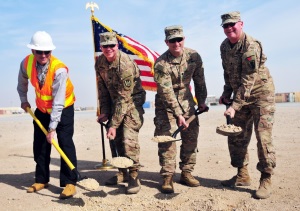Courtesy Story By: Capt. Maria Mengrone
Posted On: Feb. 22, 2017
 Photo By Capt. Maria Mengrone | On Feb. 14, 2017, Camp Buehring officials broke ground on the $3.7 million Essayons Village complex which will include a series of buildings for future engineer brigades and battalions supporting operations in the Middle East. Pictured (left to right) Mr. Raymond Soto, Program Operations Senior Director for Vectrus and resident of New York City, N.Y., Lt. Col. Carl W. Aufdenkampe, Director of DPW-North and hails from Fort Huachuca, Ariz., Lt. Col. Christopher M. Leung, Camp Commander of Camp Buehring and resident of Champaign, Ill., and Chaplain (Lt. Col.) Maurice D. Millican, representing Soldiers of the 176th Engineer Brigade (Task Force Chaos) and resident of Harker Heights, Texas. (U.S. Army National Guard photo by Capt. Maria Mengrone/Released)
Photo By Capt. Maria Mengrone | On Feb. 14, 2017, Camp Buehring officials broke ground on the $3.7 million Essayons Village complex which will include a series of buildings for future engineer brigades and battalions supporting operations in the Middle East. Pictured (left to right) Mr. Raymond Soto, Program Operations Senior Director for Vectrus and resident of New York City, N.Y., Lt. Col. Carl W. Aufdenkampe, Director of DPW-North and hails from Fort Huachuca, Ariz., Lt. Col. Christopher M. Leung, Camp Commander of Camp Buehring and resident of Champaign, Ill., and Chaplain (Lt. Col.) Maurice D. Millican, representing Soldiers of the 176th Engineer Brigade (Task Force Chaos) and resident of Harker Heights, Texas. (U.S. Army National Guard photo by Capt. Maria Mengrone/Released)
CAMP BUEHRING, Kuwait – Camp Buehring officials broke ground on the construction of the $3.7 million Essayons Village complex which will include a series of buildings for future engineer brigades and battalions supporting operations in the Middle East, Feb. 14, 2017, Camp Buehring.
The village will consist of seven pre-engineered buildings which will include workspace for one engineer brigade, two engineer battalions, and four company headquarters.
“Right now the brigade headquarters and a lot of their battalion headquarters are in tents; the environmental control isn’t as good and they work out of temporary partitions and cubicles,” said Camp Commander of Camp Buehring Lt. Col. Christopher M. Leung and resident of Champaign, Ill.
Planning for the project began as early as February 2016 and final approval was granted in September 2016.
“Each building has its own scope of work so each building required its own development plans,” said Project Manager Capt. Joshua J. Flury, 308th Engineer Facilities Detachment, Brigade Support Troops Battalion, Directorate of Public Works-North (DPW-N).
The work for the project is contracted with an expected completion date of Sep. 12, 2017.
“The brigade headquarters building will be able to support about 50 personnel. But some of the other buildings are roughly 100 square meters, they will include space for a company commander, company first sergeant and a common area where administrative tasks can be completed. Each building will have its own male and female latrine directly connected to the building,” said Flury.
Onlookers at the ceremony included currently serving Soldiers of the 176th Engineer Brigade, Task Force Chaos, of the Texas Army National Guard.
“I know we won’t be able to enjoy the Essayons Village but it was important that we were able to be part of this ceremony. It’s always great to know that the follow on engineer units will have a more suitable work environment,” said Senior Enlisted Advisor of the 176th Engineer Brigade Command Sgt. Maj. Anthony Simms, a native of Copperas Cove,Texas.
The ceremony for Essayons Village is the first of many projects expected for Camp Buehring.
“This is just another part of Camp Buehring’s continued progress. We are growing and continuing to look at new projects to improve things for the tenants who live and work here,” said Leung.
“This investment in Essayons Village is evidence of the important role the Engineer Regiment is playing throughout the USCENTCOM Area of Responsibility,” said Task Force Chaos Commander, Col. Charles M. Schoening, a Georgetown, Texas resident. “Engineer operations in this theater will continue to be a primary focus and will require enduring facilities for headquarters elements to support mission command functions.”
“Essayons” is French for, “Let us try,” and the adopted motto of the U.S. Army Engineer Regiment.